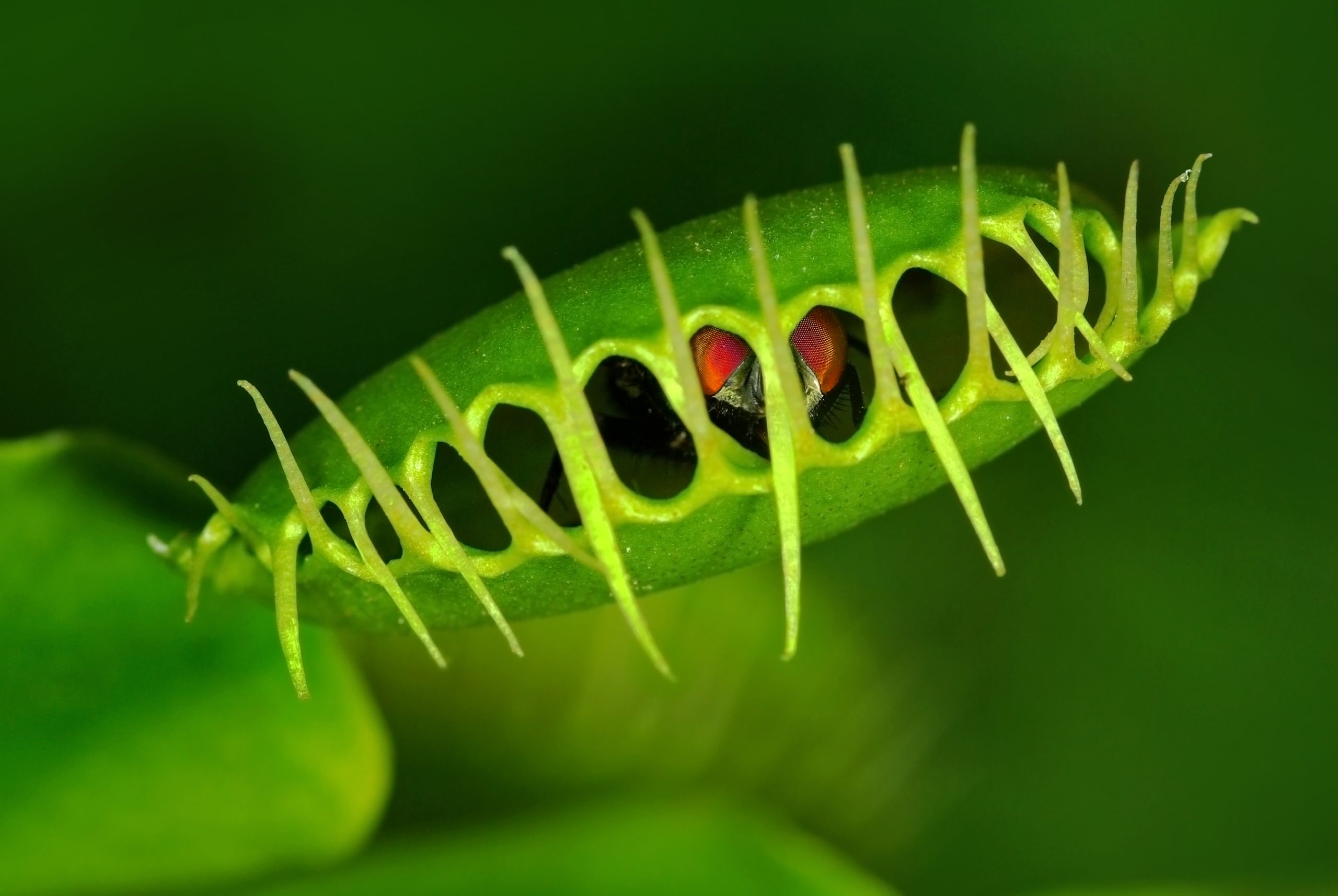Nature’s Marvel: 10 Interesting Facts About Venus Flytraps

Welcome to “Nature’s Marvel: 10 Interesting Facts About Venus Flytraps”—a blog post dedicated to unraveling the mysteries of one of Mother Nature’s most intriguing creations.
The Venus Flytrap, with its jaw-like leaves that snap shut on unsuspecting prey, has long captivated the imaginations of scientists, hobbyists, and the curious alike.
This carnivorous plant, seemingly ripped from the pages of a fantasy novel, is a genuine marvel of evolution. Apart from its unique method of catching prey, the origin of its name adds to its enigmatic presence.
In this post, we’ll explore the fascinating world of Venus Flytraps, providing a brief overview of these captivating carnivorous plants and shedding light on the story behind their extraordinary name.
Join us as we plunge into the depths of nature’s ingenuity, examining why Venus Flytraps are considered one of the planet’s most phenomenal living organisms.
The Origin of Their Name
The name “Venus Flytrap” is as captivating as the plant itself, rooted deep in historical lore and botanical nomenclature. This unique moniker is thought to have been inspired by Venus, the Roman goddess of love and beauty, which reflects the plant’s enticing nature.
Its leaves, resembling open jaws, lure insects not just by their vivid color but also by the sweet nectar they exude. Once an unsuspecting prey touches the sensitive hairs inside, the trap snaps shut, imprisoning the insect.
The term “Flytrap” plainly describes the plant’s remarkable method of capturing its prey, akin to a trap set for flies. The fusion of beauty and function in the Venus Flytrap’s name highlights the duality of nature—a theme that resonates throughout its existence.
This name not only reflects the plant’s unique feeding mechanism but also places it on a pedestal of nature’s marvels, bridging the gap between the botanical world and mythological allure.
Habitat and Distribution
The Venus Flytrap, a botanical wonder, is natively found in a select few regions, showcasing its rarity and exclusivity. Predominantly, these plants grace the subtropical wetlands of the East Coast of the United States, with a significant concentration in North and South Carolina.
In these specialized habitats, Venus Flytraps thrive in nutrient-poor, acidic soils where competition from other vegetation is minimal. Their distinct choice of habitat, often open areas that receive plenty of sunlight such as wet savannahs and bogs, is crucial for their survival.
The environment must be well-drained yet maintain consistent moisture — conditions that simulate their natural habitats. This delicate balance of habitat requirements is what makes the Venus Flytrap both fascinating and challenging to conserve in the wild.
Their specific environmental needs highlight the intricate relationship between carnivorous plants and their ecosystems, underscoring the importance of habitat preservation for these captivating species.
Unique Feeding Mechanism
The unique feeding mechanism of the Venus Flytrap is a marvel of nature’s engineering, fascinating botanists and nature enthusiasts alike. These carnivorous plants catch their prey through a highly specialized process that starts with the luring of insects to their jaw-like leaves.
The leaves are lined with sensitive hairs, and when an insect touches them, it triggers the trap to snap shut in less than a second, capturing the prey inside.
This rapid closure is the result of changes in water pressure within the plant cells, a phenomenon that has intrigued scientists for centuries. Once the insect is securely trapped, the Venus Flytrap secretes digestive enzymes to break down and absorb the vital nutrients from its prey.
This process can take up to ten days, after which the leaf reopens, ready to claim its next victim. This intricate feeding strategy allows the Venus Flytrap to thrive in nutrient-poor soils, illustrating a remarkable adaptation to their environment.
What Do They Eat?
The diet of a Venus Flytrap is primarily composed of a variety of insects and arachnids, marking it as a versatile predator in its ecosystem. Common prey includes flies, ants, spiders, and even small beetles, which provide the essential nutrients that the plant cannot derive from the nutrient-poor soil of its native habitat.
The misconception that Venus Flytraps can digest larger animals and pose a danger to pets is entirely unfounded. These plants are specifically adapted for capturing and digesting small invertebrates, relying on the nitrogen and other minerals they obtain from their prey to compensate for the lack in their environment.
This diet, focused on small bugs, dispels the myths of a man-eating plant, spotlighting instead the remarkable adaptability and survival strategy of the Venus Flytrap in its niche.
Growth and Reproduction
The growth cycle and reproduction methods of Venus Flytraps add yet another layer to their fascinating biology. Venus Flytraps exhibit a perennial growth pattern, emerging from a bulb-like structure beneath the soil. In spring, they sprout from seeds or the division of their underground rhizomes, signaling the start of their growth cycle.
These plants go through a dormancy period during the colder months, a crucial rest phase that enables them to survive and thrive year after year. When it comes to reproduction, Venus Flytraps can multiply both sexually and asexually.
Sexual reproduction occurs through pollination, where flowers at the top of long stems produce seeds that give rise to new plants.
Asexually, they can propagate through the division of rhizomes, where each section of the root-like stem can grow into a new plant. This blend of reproductive strategies ensures the survival of the species, allowing it to spread across its native habitat despite the specific and challenging environmental conditions it requires.
Conservation Status
The conservation status of the Venus Flytrap paints a concerning picture, underlining the urgent need for protective measures. Currently, Venus Flytraps are classified as “Vulnerable” on the International Union for Conservation of Nature (IUCN) Red List, signaling a high risk of endangerment in the wild.
The primary threats to their survival stem from habitat destruction and illegal poaching. Urbanization and agricultural expansion have led to significant reductions in their natural habitats, particularly in the coastal regions of the Carolinas where they are endemic.
Furthermore, the allure of these captivating plants has fueled an illicit trade, with poachers uprooting them for sale in domestic and international markets.
Such activities not only deplete natural populations but also compromise the delicate ecological balance within their native environments. To safeguard the future of Venus Flytraps, a combination of legal protection, habitat restoration, and public education is paramount, emphasizing the critical role these plants play in the biodiversity of their ecosystems.
Venus Flytraps in Popular Culture
Venus Flytraps have captivated the imagination of popular culture, featuring prominently in movies, books, and other media, often imbued with a sense of mystery and otherworldliness. Perhaps the most iconic representation is the man-eating plant, Audrey II, in the musical and subsequent movie adaptation, “Little Shop of Horrors,” where a seemingly innocent Venus Flytrap transforms into a carnivorous monster with a taste for human flesh.
This theatrical depiction, while largely fantastical, highlights the plant’s exotic allure and predatory mechanism in a humorous and exaggerated fashion.
In literature, Venus Flytraps have made appearances in various forms, from key plot devices in mystery novels to fascinating subjects in non-fiction science books aiming to educate young minds about the wonders of the natural world.
The portrayal of Venus Flytraps in video games and cartoons also often exaggerates their size and abilities, depicting them as giant, menacing traps lurking in jungle settings, ready to snap at unsuspecting characters.
Across these mediums, Venus Flytraps are symbolized as both intriguing and slightly ominous beings, showcasing humanity’s enduring fascination with these remarkable plants.
Caring for Venus Flytraps at Home
Caring for Venus Flytraps at home is a rewarding experience that introduces you to the fascinating world of carnivorous plants right from the comfort of your living space. To ensure that your Venus Flytrap thrives, it’s crucial to mimic their natural habitat as closely as possible.
This means providing them with plenty of sunlight—at least four hours of direct sunlight daily—and maintaining high humidity levels, which can be achieved by placing the pot in a tray of distilled water to mimic the boggy conditions they love.
Venus Flytraps prefer nutrient-poor, acidic soil, so it’s best to use a mixture of sphagnum peat moss and perlite. Avoid the common mistake of using tap water, as the minerals can accumulate and harm the plant; instead, opt for rainwater or distilled water.
Additionally, resist the temptation to “feed” the plant artificially by triggering its traps; this expends the plant’s energy unnecessarily and can weaken it over time.
Remember, with little patience and by paying attention to their specific needs, growing Venus Flytraps can be a bewitching addition to your home’s flora.
Fun Facts
Venus Flytraps are surrounded by an aura of mystery and fascination, not just for their carnivorous nature but also due to the treasure trove of surprising truths beneath their captivating traps. One of the most astonishing facts is that these beguiling plants can count.
Studies have shown that Venus Flytraps keep track of the number of times their prey touches their sensory hairs, requiring two touches to snap shut and additional touches to start digesting. What’s more, they can differentiate between a false alarm and actual prey, ensuring they conserve energy for genuine feeding opportunities.
Another intriguing aspect is their lifespan; Venus Flytraps can live up to 20 years, a fact that contrasts sharply with the ephemeral nature of their individual traps, which can only open and close a few times before dying off.
Additionally, despite their formidable reputation, these plants are incredibly small, with traps typically measuring only up to 1 inch long.
This combination of intellect, longevity, and size makes Venus Flytraps a truly mesmerizing species, debunking myths and revealing their complexity and efficiency as one of Mother Nature’s most intriguing creations.
Conclusion
In conclusion, the Venus Flytrap stands as a testament to the intricate beauty and complexity of nature. From their unique carnivorous lifestyle to their astonishing ability to count and discern between prey and false triggers, Venus Flytraps embody the marvels that the natural world holds.
These plants not only challenge our understanding of the botanical realm but also offer insights into the adaptability and ingenuity of life.
However, as we have explored, their survival hangs in a delicate balance, threatened by habitat destruction and illegal poaching. Their status as a ‘Vulnerable’ species underscores the imperative need for conservation efforts to protect these and other carnivorous plants.
By supporting measures that aim to preserve their natural habitats and furthering research into their ecological roles and physiological mechanisms, we not only safeguard these fascinating species but also enrich our knowledge and appreciation of biodiversity.
The Venus Flytrap’s story is a compelling reminder of the wonders that await our discovery and the critical importance of protecting nature’s marvels for generations to come.




